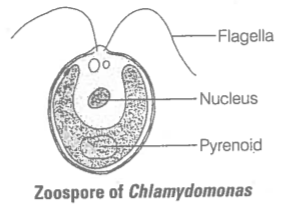Algae and their spores exhibit enormous diversity and they vary greatly in their level of specialisation. Asexual reproduction by spores and their types are described below
(a) By Zoospores These are mobile flagellated spores. In which protoplasm of each
vegetative cell undergoes repeated longitudinal division either into 2 or 4 rarely 8 or 16
daughter protoplast. The parent cell loses its flagella, before the onset of division.
After the last series of division, each daughter protoplast secretes a cell wall and
neuromotor apparatus that develops two flagella, eyespots and contractile vacuoles.
Thus, each of the daughter cell formed resembles the parent cell in all aspects except
the small size.
Formation of zoospores is very common under favourable conditions.
(b) By Aplanospores These are the non-motile spores. They are asexually formed with ina
cell, in this the protoplast withdraws itself from the parent wall, rounds up and develops
into aplanospores which may either germinate directly or may divide to produce
zoospores.
(c) By Hypnospores In this, the protoplasm withdraws from the cell wall, rounds up an
develop a thick wall under unfavourable condition. These resting spores are called as
hypnospores. They are red in colour due to presence of haematochrome.
e.g., Vaucheria, Ulothrix.
(d) Akinetes These are special vegetative thick walled cells present in the filaments which
remain under dorment state and return to germination under favourable condition and
can also with stand unfavourable condition as Spirogyra.
(e) Statospores This are thick walled spores produced in diatoms.
(f) Neutral Spores In some algae, the protoplast, of vegetative cells directly functions as spores called as neutral spores (e.g., Ectocarpus).


